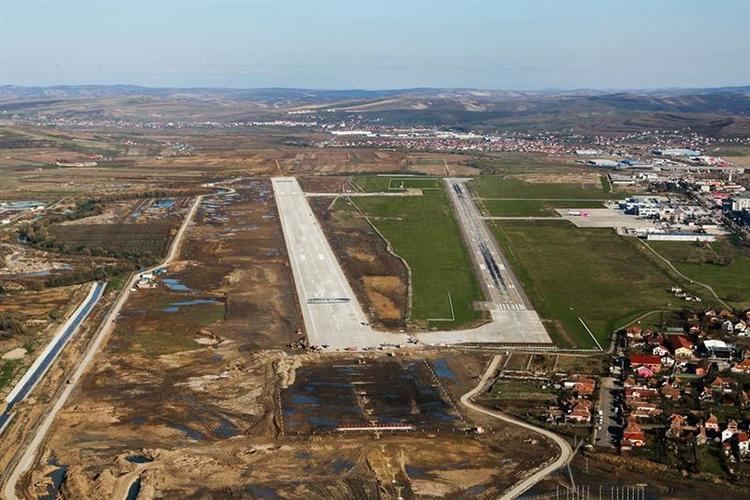Airport type Public Elevation AMSL 1,036 ft / 315 m Code CLJ Phone +40 264 307 500 Yearly aircraft movements 19,152 | Focus city for Blue AirWizz Air Website airportcluj.ro Elevation 316 m Owner Cluj County Passenger count 1,880,319 | |
 | ||
Profiles | ||
Wizz air landing cluj napoca international airport
Avram Iancu Cluj International Airport (IATA: CLJ, ICAO: LRCL) is an airport serving the city of Cluj-Napoca, Romania. Initially known as Someșeni Airport, it is located 9 km (5.6 mi) east of the city centre, in the Someșeni area, which is now within the Cluj-Napoca city limits. The airport is named in honour of Romanian revolutionary Avram Iancu.
Contents
- Wizz air landing cluj napoca international airport
- History
- Passenger
- Ground transportation
- Accidents and incidents
- References
In terms of passengers' traffic, Cluj Airport is the second busiest airport in Romania, after Bucharest Henri Coandă, handling 1.88 million passengers in 2016. Its size and location (on the European route E576 and close to A3 Transylvania Motorway) makes it the most important airport in the historical region of Transylvania.
History
Cluj Airport was founded on 1 April 1932 by the Romanian Ministry of Industry and Trade. Until the civil airport was built, the first operations used the Someşeni Military Aerodrome that was founded by the Romanian National Service of Air Navigation (Romanian: Serviciul Naţional de Navigaţie Aerianǎ SNNA) in 1928. The SNNA was set up by the Romanian Ministry of War for opening an air transportation line between Cluj and Bucharest. The first aircraft used was the Farman-Goliath aircraft, a twin-engine plane with space for ten passengers built by the Farman Aviation Works.
In 1933, Cluj Airport was declared an International Airport by the Romanian Government. The first international flight, a CSA Czech Airlines Prague-Cluj-Bucharest flight, took place on 11 September 1933. The aircraft used on this route were eight-seat Avia-Fokker aircraft. In the following years, several new routes were opened, such as the Aeroflot Moscow-Cluj-Prague flight, opened on 15 November 1935, which was operated with 14-seat McDonnell Douglas DC-2 twin-engine aircraft, registered as USSR-M25 and USSR-M26. Internal flights were also operated in this period, such as Cluj-Satu-Mare and Cernăuţi-Cluj-Arad using Lockheed Model 10 Electra ten-passenger aircraft and de Havilland Dragon Rapide aircraft. In the late 1930s the airport recorded a steady growth and the employees number rose from 6 in 1934 to 16 in 1939. The passenger terminal was also built in this period, being inaugurated in 1939.
During World War II, the airport became a military airport, as it was considered to be the most important in Transylvania. In 1940, as a result of the Second Vienna Award, Northern Transylvania (including Cluj) was ceded to Hungary and thus the airport was used by the Hungarian Air Force and German Luftwaffe. Malert airline also operated flights to Budapest during these years. In October 1944, the Hungarian forces in the city were defeated by the Romanian and Soviet armies. By the time of the reconquest of the airport by the Romanian No. 4 Fighting Squadron Focşani, in late September 1944, the airport was completely destroyed.
After the war, the airport's operations were resumed with TAROM internal flights connecting Cluj to other major Romanian cities. The aircraft used were the Lisunov Li-2 / Douglas DC-3 and Ilyushin Il-14 aircraft.
In the 1960s, an extensive modernization of the airport began. In 1969, a new passenger terminal was opened. By 1970, the airport was fully equipped with all of the safety facilities.
The airport remained a domestic airport until September 1996, when it was once again opened to both international passenger and cargo traffic. The extension of the terminal building was also started in 1996 and since August 1997 it is run by the Cluj County Council. By 2001, the extension of the airport building was finished, the runway lighting system was modernized, and an Instrument Landing System (ILS) CAT I equipment was implemented.
In 2007 and 2008, the Cluj airport had the most spectacular evolution in recent years, with a year-over-year growth of 60% and 93% respectively, reaching over 750,000 passengers in 2008.
The construction of a new terminal, capable of handling 2 million passengers annually, started on 26 June 2007. The 10,812 m2 (116,380 sq ft) arrivals hall was inaugurated on May 22, 2008, followed by the new departures hall, with a total area of 16,000 m2 (170,000 sq ft), inaugurated in May 2009. Total project cost was an estimated €40 million. In February 2009, the ILS equipment was upgraded to CAT II.
Cluj Airport exceeded the 1,000,000 passenger mark in 2010. On 8 September 2011, the construction works for building a new runway of 2,100 m (6,890 ft) began. The works represented the first phase of the investment that aims at a take-off/landing runway of 3,500 m (11,483 ft). The new runway 07/25 officially went into operation on 26 October 2013. The old runway 08/26 became a taxiway, after the new runway opened.
In 2014, ROMATSA held a competition for the creation of a new control tower for Cluj-Napoca Airport. Of the 22 projects that were submitted in the competition, as winner the project of Outline Architecture Office was chosen, an architectural design office based in Bucharest. The tower resembles a tulnic and will have a height of 42 m. The costs for the construction of new control tower will be borne by ROMATSA.
Passenger
The following airlines operate regular scheduled and charter flights to and from Cluj-Napoca:
Ground transportation
The airport is located 8 km (5.0 mi) east of the city centre on the European route E576. The drive from the city centre takes about 20 minutes. Car rental services are available in the terminal building. CTP Cluj Napoca, the local public transport company, operates its Route No. 8 that connects the airport with the Mihai Viteazul Square in the City Center and trolleybus No. 5 to the Rail station.
